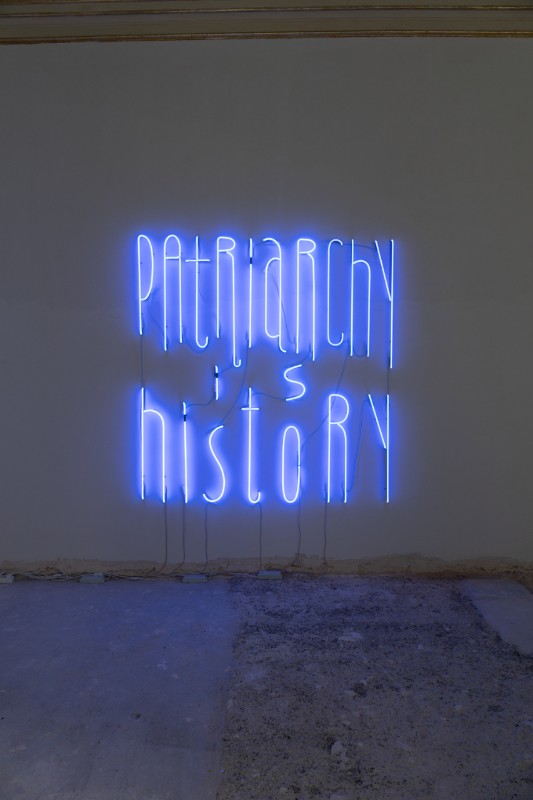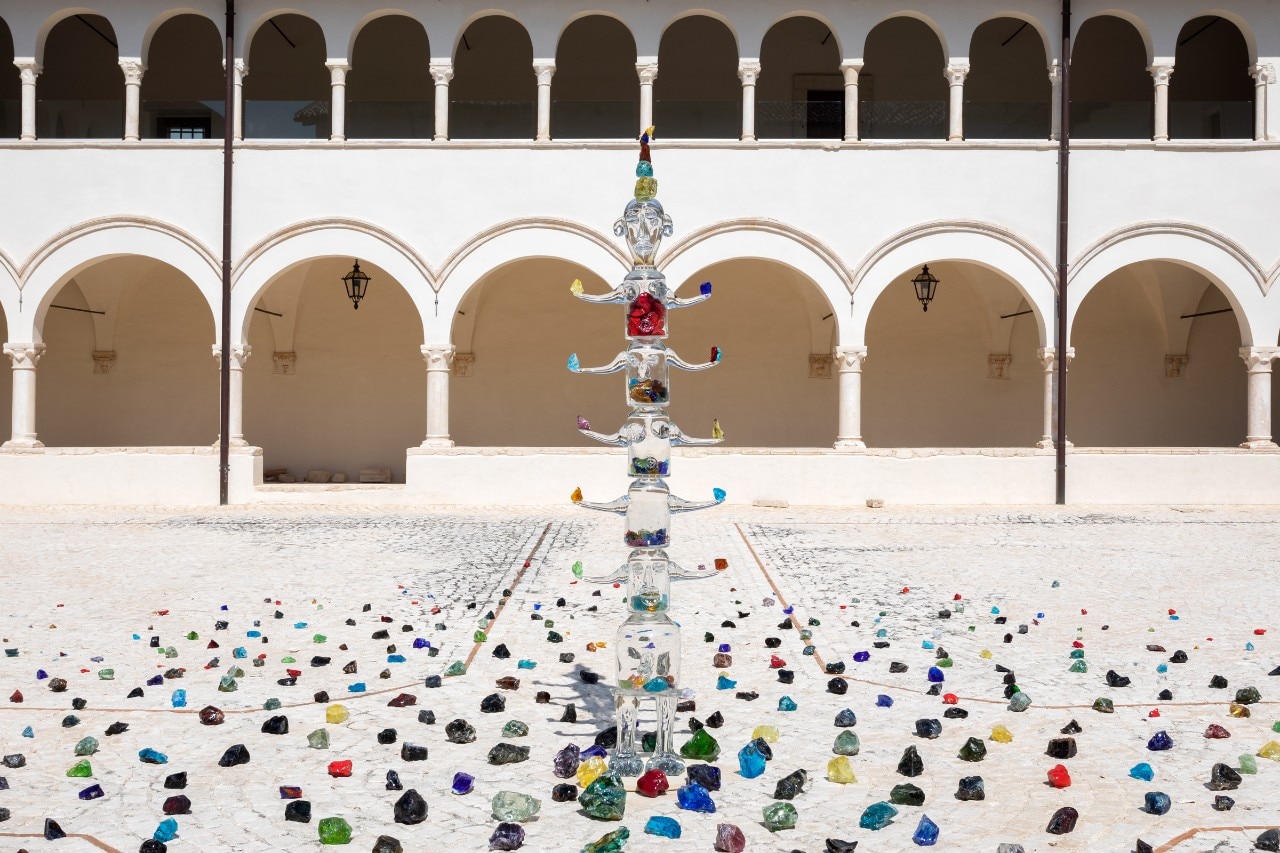“I’m a tourist in my own city”, remarked a lady talking about Panorama – she was leisurely strolling along Corso Vittorio Emanuele, L’Aquila’s main street, on a Saturday morning. Curated this year by Cristiana Perrella, the Abruzzo capital’s exhibition-event stands out from the multitude of cultural happenings in urban settings. Not only does it seamlessly combine contemporary, modern and ancient art, but it is the only event that fosters the collaboration, in private and public spaces, of about sixty of the most important art galleries in the country and beyond. These galleries are united under the “Italics” consortium, a name that is both evocative and ambitious.
.jpg.foto.rmedium.jpg)
Conceived on April 25, 2020 through the joint vision of Lorenzo Fiaschi of Galleria Continua and Pepi Marchetti Franchi of Gagosian, this unique pseudo-collective is composed of diverse and distinctly individual personalities. Their primary goal is to promote projects that facilitate the convergence of art, Italian heritage, landscapes, and communities. In this context, Panorama, the annual flagship event of Italics, has chosen to extend its reach this year to the historic center of L’Aquila, following previous successful editions in Monopoli (2022) and Procida (2021).
Compared to previous editions, this year’s project embarks on a novel endeavor, immersing itself in a city marked by a recent and tragically burdensome history, where over a hundred works of art engage in dialogue across twenty different exhibition venues. These venues range from the city’s museums to private aristocratic palaces usually closed to the public, such as the Casino delle Delizie Branconi and Palazzo Rivera, and even extend into public spaces, where Maurizio Nannucci’s aerial banner Let’s talk about art (2023) stakes a claim in the sky. A key element of the event is the reopening of some of the city’s most important buildings, meticulously restored after suffering severe damage in the 2009 earthquake, as well as the remarkable hosting of those still undergoing restoration.
.jpg)
The city boasts a number of research and exhibition centers dedicated to contemporary art, and this rich cultural heritage extends beyond the capital to the entire region. The region’s deep historical roots have been thoughtfully integrated into numerous exhibition spaces. This is exemplified by works such as Spalletti’s Colonna persa con ombra (2001) and Lucio Fontana’s Crocifisso (1954-55) in the restored Santa Margherita in Forcella, with its local terracotta floor, and in the chapel of the historic Palazzo Nardis. In addition, Massimo Bartolini’s fitting installation in the Oratorio di Sant’Antonio dei Cavalieri de Nardis engages viewers as a large carillon plays in dialogue with one of the few seventeenth-century organs still in impeccable working condition. On a more contemporary note, Renzo Piano’s Auditorium serves as a venue for various events, including the premiere of Wim Wenders’ film dedicated to the eminent figure of Anselm Kiefer.
The city’s fervent desire for vitality first became evident in efforts to transform record stores, cafes, and shops into unconventional exhibition spaces. This was the case, for example, with the interventions of Luca Trevisani, who, in collaboration with Førma Bakery, artfully baked daily batches of artist’s bread (Panpestato, 2023) and presented his unique bread sculptures made of shoe soles in a former shoemaker’s shop, now sadly vacant. A series of performances also added to the exhibition’s urban vibrancy. Especially notable was Darren Bader’s antipodes: musical quartets, a sound-infused concert that literally took place among the scaffolding of Marcello Mariani’s former studio.
.jpg)
Speaking of urban regeneration and social planning, it’s worth noting the significant presence of Ugo La Pietra, a native of Abruzzo (born in Chieti). La Pietra’s remarkable talent for balancing the environment with his work and his innovative approach to reimagining urban spaces, all while steering clear of the pitfalls of musealization, did not go unnoticed. In recognition of his contributions, Panorama awarded this artist, architect and designer – an independent and visionary thinker with an almost anthropological perspective – with the Italics Oro Award. This prize, awarded annually, celebrates the deep bond between an artist and their native land.
The words of the lady from L’Aquila were simple. But they became food for thought amidst the hustle and bustle of moving between the exhibition venues. They invite us to reflect on the event’s impact on the city. Two contributions, donated both to the city and to the Museo Nazionale d’Abruzzo (MuNDA), were of great importance: Enigma della Materia (2023) – Alberto Di Fabio’s expressive outdoor mosaic with its dynamic lines – and Gianni Caravaggio’s work, a flag that transcends nationalism and hegemony, embracing only the colors of the Apennine landscape that surrounds and sustains the city (Bandiera naturalizzata, L’Aquila, 2023).

Also outstanding is the work of Giuseppe Stampone, a native of Abruzzo, who traces the artistic history of the region in his works with Bic pen strokes, capturing the essence of this concept in his work entitled Aprutium (2023). Equally profound, though more subtle, are the resonances found in the textile piece Xanî Xanî Xanî (2021) and the photographic work The Owl’s Made a Nest in the Ruins of the Heart: Film Still I (2021) by Iranian artist Shadi Harouni. These pieces reflect on the growing housing and migration crisis resulting from unfulfilled political promises. Similarly powerful are the large-scale photographic series “Roman Allegories” (2004) by US-based artist Eleanor Antin. These works use sarcasm to comment on the idea of ruin in a declining contemporaneity. Paolo Icaro’s Il Sogno dello Spigolo (2023) is also at the intersection of memory and oblivion, permanence and impermanence. Specifically designed for the courtyard of the eighteenth-century Palazzo Ardinghelli, which houses MAXXI (currently exhibiting the wonderful works of Marisa Merz and Shilpa Gupta), Icaro’s piece consists of an ironic edge resting on two cushions. “I feel I am participating in the spirit of reconstruction,” says Icaro, acknowledging the ongoing work required to rebuild L’Aquila.
With this symbolic impetus for reconstruction, we bring our brief review to a close. According to the website of the USRA – Special Office for the Reconstruction of L’Aquila, the reconstruction of the entire area should be completed by 2024. However, scaffolding and support structures can still be seen at every turn. Panorama, in and of itself, may not single-handedly regenerate the urban and social fabric of L’Aquila, but it undoubtedly serves as a catalyst, drawing attention to this city. It shines a spotlight on the gradual yet ongoing process of redevelopment and regeneration, driven by the imaginative and connective power of art.




.jpg.foto.rmedium.png)
.jpg.foto.rmedium.png)
.jpg.foto.rmedium.png)
.jpg.foto.rmedium.png)
.jpg.foto.rmedium.png)
.jpg.foto.rmedium.png)
.jpg.foto.rmedium.png)
.jpg.foto.rmedium.png)
.jpg.foto.rmedium.png)
.jpg.foto.rmedium.png)
.jpg.foto.rmedium.png)
.jpg.foto.rmedium.png)
.jpg.foto.rmedium.png)
.jpg.foto.rmedium.png)
.jpg.foto.rmedium.png)
.jpg.foto.rmedium.png)
.jpg.foto.rmedium.png)
.jpg.foto.rmedium.png)
.jpg.foto.rmedium.png)
.jpg.foto.rmedium.png)
.jpg.foto.rmedium.png)
.jpg.foto.rmedium.png)
.jpg.foto.rmedium.png)
.jpg.foto.rmedium.png)
.jpg.foto.rmedium.png)
.jpg.foto.rmedium.png)
.jpg.foto.rmedium.png)
.jpg.foto.rmedium.png)
.jpg.foto.rmedium.png)
.jpg.foto.rmedium.png)
.jpg.foto.rmedium.png)
.jpg.foto.rmedium.png)
.jpg.foto.rmedium.png)
.jpg.foto.rmedium.png)
.jpg.foto.rmedium.png)
.jpg.foto.rmedium.png)
.jpg.foto.rmedium.png)
.jpg.foto.rmedium.png)
.jpg.foto.rmedium.png)
.jpg.foto.rmedium.png)
.jpg.foto.rmedium.png)
.jpg.foto.rmedium.png)
.jpg.foto.rmedium.png)
.jpg.foto.rmedium.png)
.jpg.foto.rmedium.png)
.jpg.foto.rmedium.png)
.jpg.foto.rmedium.png)
.jpg.foto.rmedium.png)
.jpg.foto.rmedium.png)
.jpg.foto.rmedium.png)
.jpg.foto.rmedium.png)
.jpg.foto.rmedium.png)